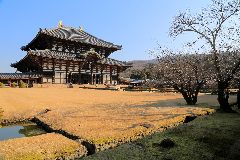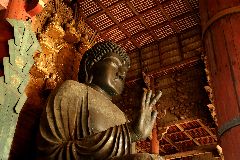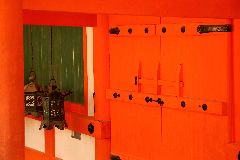Where Buddha arrived to Japan
Japan's first capital city with some Buddhist superlatives, no trash bins and bunch of deer
Next day I moved for one day to Nara, not far away from Kyoto. Nara was the first “permanent” capital of Japan, but permanent in this case means just 75 years. It was before Kyoto and it was when Japanese ruling dynasty embraced Buddhism. Buddhism was actually the key factor in this.
When Shintoism was the one and only religion in Japan its mystic principles requested that the capital city is moved every time that the emperor died. Together with the emperor his capital had to pass away as well and a new one had to be built. When Buddhism arrived and the ruling dynasty approached it, suddenly it was not necessary to keep on moving capital every time the emperor died and so Nara happened to be the first permanent capital. Only 75 years the ruler decided to move the capital to Kyoto because of strategic reasons (and to eliminate the rising power of Buddhist clerics in Nara). As with many other cities that remain nicely intact, Nara also thanks for its historic feeling to its quick rise and quick decline in importance. Large temples and palaces were built, but as the city’s significance decreased there was no reason for enlarging and rebuilding the city, the process which typically costs the cities its historic monuments. And so Nara is full of those ancient temples, imperial park and other goodies. And messengers of gods (Shinto gods) – deer.
There’s a whole lot of Buddhist temples but the two most prominent ones are Todai-ji and Gango-ji. Todai-ji is the largest wooden building in the world and it houses Daibutshu – Great Buddha - the largest Buddha statue in the world located inside a building. It’s a massive bronze casted Buddha sitting in this beautiful temple, which had been actually even larger few centuries ago.
Gango-ji is said to be the oldest Buddhist temple in Japan. It’s original location was somewhere else (n Asuka) but they moved it from that nearby place to Nara. This is the temple where Japanese zen started. It was exciting to see the Mother of Zen.
Apart from temples and there’s bunch of magnificent Japanese gardens there, gangs of tourists robbing deer that roam the streets and the park, wonderful old tea master’s house which now serves as a hostel where I slept and I even witnessed a “great fire ceremony” which turned out to be a bit disappointing act of few Buddhist novices running around temple’s veranda with bamboo sticks with burning ends. It was funny how hundreds of Japanese people who were watching this ceremony where ohh-ing and ahh-ing every time a novice would run from one side of the veranda to other one, as if they had never seen anything so amazing. Here in the land of the future where all world’s oddities are at home it was cute to see how those nice Japanese people get excited about such a unspectacular event.
To keep this post short, I will mention just one key observation and one key learning from Nara.
Observation: In Japan there are almost no trash bins. Just like in India, but while in India it means that trash bin is simple everywhere around you – just drop it on ground and continue walking – in Japan it means that you have to carry all your trash for kilometers until you find one.
Learning: Fake converse shoes from Bali are indeed not the best shoes for walking for 13 hours in early spring with occasional snowfall. My feet were frozen by the time I returned to hostel.
After spending one night in Nara and sightseeing the next day, I returned to Kyoto to spend my last night there sleeping in a capsule. Capsule hotels are great Japanese invention, fusion of hotel and hostel. One big room houses 8 – 100 of beds, bud each bed has its little room build around it. It’s called a capsule and pretty much it’s a bed inside a box which is high enough to sit inside it. There is always air conditioning and TV inside the capsule and the capsule hotel which I found (and which was quite high-end capsule hotel) had also internet plug inside the capsule. It’s unexpectedly comfy in the capsule. I mostly went there for the experience of it (it was actually more expensive than normal hostel), but I have to say it’s a good invention. The hotel even had a bath tub and so, after 1 year and 4 months I had a hot bath. Ahhhhh!



